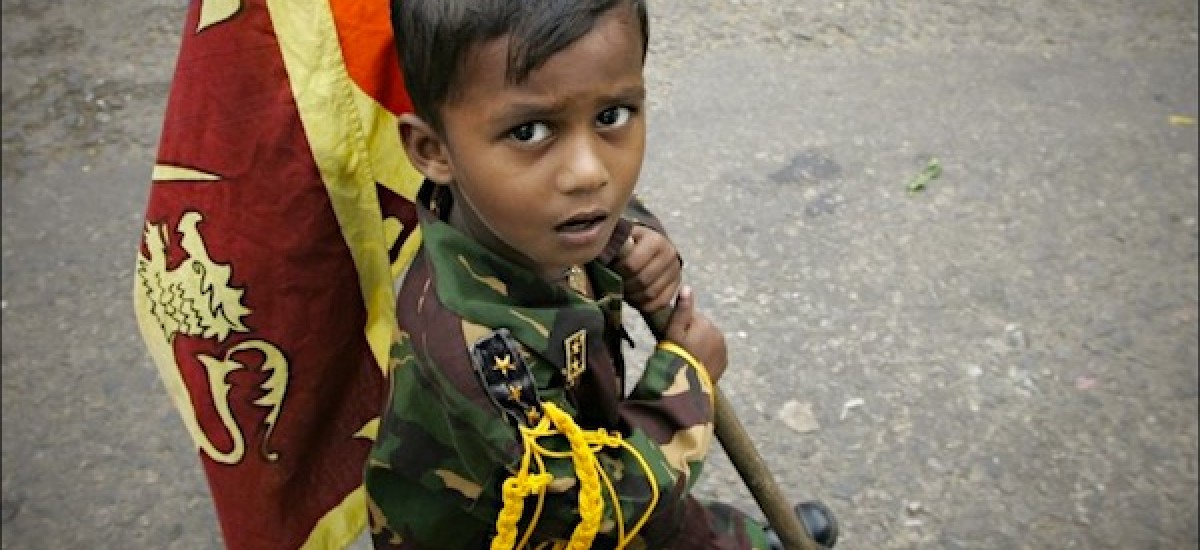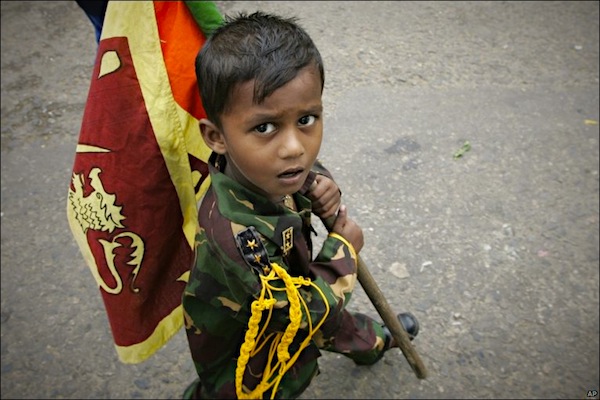Image credit AP, via BBC News
“There are two mistakes one can make along the road to truth…not going all the way, and not starting.” – Lord Buddha
Authors note: When I was a teenager, I heard from a Sinhala brother that he constantly felt guilty for being unable to protect nearly 70 000-80 000 Sinhala youth who were killed in 1971 and 1989 by their own government in the name of ‘countering insurgency’.
Now, approaching my tenth year of engagement in journalism and human rights activism, I am experiencing a similar feeling. When thousands of Tamil civilians were massacred under the banner of ‘defeating terrorism’, I – along with like-minded others –could not cease or control the causalities. Since then, it has been my sole intent to do something constructive and seek justice for those who were victimized by the state system in Sri Lanka.
(An edited version of an article by Nirmanusan Balasundaram as first published in the UNESCO Chair & Institute of Comparative Human Rights publication entitled, International Leadership Programme: A Global Intergenerational Training Forum. This is an edited version. )
Introduction
The war in Sri Lanka came to an end in the Spring of 2009 with serious violations of International Humanitarian Law and gross violations of International Human Rights Law. Since then, the pressure from the international community is mounting on accountability issues and victimized Tamil community is seeking justice. However, the long standing impunity still defending the perpetrators and prevailing as a key obstacle to seek justice and genuine reconciliation in the island nation. Now more than twenty-eight months since that war came to an end, there has still been no significant progress on a political solution. Instead, the GoSL rests on the laurels and the spoils that come with that military victory. Military triumph it seems is the only political solution they are willing to accept.
Background of the Conflict
An identity-based state patronage system, misrule, discrimination, oppression, exclusion and mismanagement of scarce natural resources, underdevelopment, inequality and grave human rights violations against the Tamil national minority comprise the root causes of the ethno-political conflict of Sri Lanka. The lack of moral obligation and responsibility of the successive governments of Sri Lanka steered the conflict towards a bloody war.
Unaccounted Causalities
The bloody war came to an end in May 2009. Just prior to the major offensive operations, the Government of Sri Lanka (GoSL) banned independent and international media from entering the war zone, and forced the UN and other international humanitarian organizations to leave the Liberation Tigers of Tamil Eelam (LTTE) controlled areas. Then they set about systematically killing the messengers – the journalists, human rights activists and humanitarian workers, in order to hide the truth. Yet they could not stop the truth from coming out.
In his submission to the Lessons Learnt and Reconciliation Commission, the Bishop of the Mannar Catholic Diocese, Rt. Rev. Dr. Rayappu Joseph, pointed out that, according to the Government Secretariats, the population in the Vanni region (Northern part of Sri Lanka) in early October 2008 was 429,059.
The total number of people, however, who emerged from the Vanni into government-controlled areas since then, according to UN OCHA 2009 statistics, is estimated to be 282,380, This means that over 146,679 people in the Vanni are not accounted for in post-war Sri Lanka.” [1]
The former UN spokesperson in Sri Lanka, Gordon Weiss stated: “About 300,000 civilians, plus the Tamil Tiger forces, were trapped in an area of territory about the size of Central Park in New York…They were within range of all the armaments that were being used, small and large, to smash the Tamil Tiger lines… Between 10,000 and 40,000 civilians died during the final desperate battles.”[2]
The GoSL, for their part, categorically denied the charges and claimed that they engaged in the world’s largest rescue operation to release the people from terror’s grip – a “zero-sum causality” operation. Two years after the brutal war ended, still the culture of impunity within the Sri Lankan armed forces prevails.
“In the absence of more vigorous investigations, prosecution and convictions, it is hard to see how this will come to an end, said United Nations former High Commissioner for Human Rights, Louise Arbour, during her 2007 visit to Sri Lanka. “There is a disturbing lack of investigation that undermines the confidence in the institutions set up to protect human rights,” she continued, adding that Sri Lanka’s culture of “impunity” was a serious concern. [3]
Yet the GoSL continue their justification even after concrete evidence came to light, including the televised video clip of execution of naked and blindfolded men, aired by British Channel 4 news.
“What is reflected in the extended video are crimes of the highest order — definitive war crimes,” said Christof Heyns, UN special rapporteur on extrajudicial, summary or arbitrary executions. “I believe that the prima facie case of serious international crimes has been made by the video that I’ve examined,” he told the UN Human Rights Council in May 2011.[4]
Failure and Mounting Pressure
The international community failed to prevent the brutal war and could not stop or control the causalities at the peak of the war in Sri Lanka. This is nothing less than an abysmal moral failure of the international community like genocide in Bosnia.
Louise Arbour, President & CEO of the International Crisis Group said, “It [the UN Human Rights Council] made no reference to the gross violations of human rights and international humanitarian law that had been perpetrated by the [Sri Lankan] government forces, rather it welcomed the government’s continued commitment to the promotion and protection of all human rights. Yet the last few months of the war saw several thousand civilians subjected to indiscriminate armed attacks by government forces in specially created ‘No Fire Zones’ in which they had sought protection and medical treatment.” She further stated that during the peak of the war in 2009 “international protection was not forthcoming for the civilians of Sri Lanka, and accountability and justice were dispensed quite selectively.”[5]
There were few discussions at the UN Security Council on the occasion of intensified war, including applying Responsibility to Protect (R2P) mechanisms to protect civilians. In both practice and reality, nothing was implemented to save those later slaughtered.
Nevertheless, the international community cannot continue to be silent or ignore the crimes against humanity and war crimes committed in Sri Lanka due to geo-politics trends and national interest. Following recent developments of mounting pressures from human rights defenders, international human rights institutions and international media, the UN Secretary General appointed a panel of experts (PoE) to advise him on accountability issues in Sri Lanka.
This panel found “credible allegations which, if proven, indicate that a wide range of serious violations of international humanitarian law and international human rights law were committed both by the Government of Sri Lanka and the LTTE, some of which would amount to war crimes and crimes against humanity. The Government shelled on a large scale in three consecutive No Fire Zones, where it had encouraged the civilian population to concentrate, even after indicating that it would cease the use of heavy weapons. It shelled the United Nations hub, food distribution lines and near the International Committee of the Red Cross (ICRC) ships that were coming to pick up the wounded and their relatives from the beaches. The Government systematically shelled hospitals on the frontlines. Despite grave danger in the conflict zone, the LTTE refused civilians permission to leave, using them as hostages. [6]
The Human Rights Commissioner refers to the PoE report as follows: It is incumbent on the Government to investigate these allegations and I also urge it to implement the measures recommended by the Panel. I fully support the recommendation to establish an international mechanism to monitor national investigations and undertake its own as necessary. It would be important for the Human Rights Council to reflect on the new information contained in this important report, in light of its previous consideration of Sri Lanka and efforts to combat impunity worldwide.”[7]
The Way Forward
The newly emerging international pressures on the GoSL, concerning accountability is creating a hope that justice cannot be deprived forever; in addition, paradigm shift in international attention on the human rights situation in Sri Lanka in comparison to 2009 is an indication that injustice cannot be sustained within the island nation. Also, considering the unfolding events in international relations, such as the recent Spring revolution in the Arab world and the arrest and extradition of alleged Serbian war criminal, Ratko Mladic, to the U.N. war crimes tribunal in the Hague where he will stand trial for genocide, is inspiring hope that undemocratic regimes and perpetrators cannot be sustained eternally. In Argentina, it took nearly three decades to bring perpetrators to justice, but finally it happened
Action for Positive Change
Sri Lanka is a good example that political agendas are obstacles towards the pursuit of justice. Therefore, human rights and justice should be separated from political agendas. Even, it’s challenging, with patient needs to work hard, because reform is a process of change. International human rights bodies constructive actions can abolish the existence and emergence of injustice, bad governance and disrespect of rule of law in countries like Sri Lanka. The UN Human Rights Council (UNHRC) should be a key institution to protect and promote human rights and ensure the delivery of justice for victims. But it always isn’t the case. When the war came to an end, the UNHRC held a Special Session in May of 2009 on the human rights situation in Sri Lanka and passed resolution—shockingly–in favour of GoSL. Worse, they welcomed the way the GoSL conducted the war. This resolution was adopted as twenty-nine UNHRC member countries voted in favour, six countries abstained, and thirteen countries voted against. It was passed despite the UN Secretary General’s Panel of Experts Report on accountability in Sri Lanka found credible allegations of war crimes and crimes against humanity. To ensure the integrity of the integrity of the UNHRC, its commitment for human rights values and principles enshrined in the Charter of the United Nations, the Universal Declaration of Human Rights, the International Covenants on Human Rights, and other relevant human rights instruments, the resolution should be withdrawn.
Conclusion
The culture of high-level impunity and absence of accountability will not bring justice for the people who have been deprived by Sri Lanka’s system in the past. But justice is precondition and a major step towards lasting peace in this island nation. Therefore, an era of impunity must be brought to an end without further delay. Perpetrators should be brought to justice, while the root causes of the problem and particularly grave human rights violations are also addressed. Globally known, Never Again must become a meaningful action in Sri Lanka, too rather than a repeated, attractive slogan.
[1] http://www.thesundayleader.lk/?p=31994
[2] http://www.abc.net.au/foreign/content/2009/s2814960.htm
[3] http://www.chrdsrilanka.org/PAGES/Human%20Rights%20News3.html
[4] http://news.yahoo.com/s/afp/20110530/ts_afp/srilankaunrestunrights_20110530163411
[5] http://www.crisisgroup.org/en/publication-type/speeches/2011/the-rise-and-fall-of-international-human-rights.aspx
[6] http://www.un.org/News/dh/infocus/Sri_Lanka/POE_Report_Full.pdf
[7] http://www.apc.org/en/system/files/PillayStatementHRC.pdf


